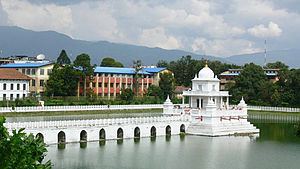 | ||
Similar Narayanhity Palace, Garden of Dreams, Hanuman Dhoka, Kathmandu Durbar Square, Patan Durbar Square | ||
Raja Pokhari (Nepali: रानी पोखरी) meaning queen's pond, originally known as Nhu Pukhu (Nepal Bhasa| न्हू पुखू) meaning new pond, is a historic artificial pond located in the heart of Kathmandu. The square-shaped tank dates from the 17th century, and was built on the eastern side of the then city limits. It lies just outside a former city gate. The pond is one of Kathmandu's most famous landmarks, and is known for its religious and aesthetic significance. Its dimensions are 180m by 140m.
Contents
- Map of Rani Pokhari Kathmandu 44600 Nepal
- Feeding the fishes at ranipokhari
- Construction
- Rani Pokhari inscription
- Famous structures
- References
Map of Rani Pokhari, Kathmandu 44600, Nepal
Feeding the fishes at ranipokhari
Construction
Rani Pokhari was built in 1670 AD by King Pratap Malla, one of the most illustrious monarchs of the Malla dynasty that ruled Nepal for more than 600 years. Pratap Malla had the tank constructed to console his queen who was distraught with grief after their son was trampled to death by an elephant. He had water collected from various holy places and river confluences in Nepal and India like Gosaikunda, Muktinath, Badrinath, Kedarnath and poured into the pond to sanctify it.
A temple dedicated to Matrikeshwor Mahadev, a form of the Hindu deity Shiva, stands at the center of the pond. It is reached from the street by a causeway. A large stone statue of an elephant bearing the images of Pratap Malla and his two sons Chakravartendra Malla and Mahipatendra Malla is situated on the tank's southern embankment. The pond is recharged by water flowing in through an underground channel.
There are four smaller temples situated at the four corners of the pond: Bhairava temples in the northwest and northeast, Mahalaxmi Temple in the southeast and Ganesh Temple in the southwest. The temples on the eastern side now lie within the compounds of Tri Chandra College and a police station which has undermined their cultural importance.
Rani Pokhari is fenced with iron bars and opened once a year during Bhai Tika, the fifth and final day of the Tihar, and Chhath festival. The world's largest Chhath festival takes place every year in RaniPokhari. Rani is also dedicated to (Nepalese Maithil) Women who goes into the cold water and pray to sun god.
Rani Pokhari inscription
The famed Rani Pokhari inscription of King Pratap Malla installed here is a stone slab with writings in three languages: Sanskrit, Nepali and Nepal Bhasa. It is dated Nepal Sambat 790 (1670 AD) and describes the construction of Rani Pokhari and its religious significance. It also mentions five Brahmins, five Pradhans (Chief-ministers) and five Khas Magars as being witnesses.
Famous structures
Rani Pokhari is surrounded by historical buildings and famous structures. The clock tower Ghantaghar is situated across the road on the eastern side of the pond. The original clock tower, which had a more elaborate architecture, was destroyed during the Great earthquake of 1934. The present clock tower was built after the earthquake. It stands on the premises of Tri Chandra College, the first college in the country which was established in 1918 AD.
On the western side of Rani Pokhari stands another historical building, Durbar High School, built in 1854 AD. It is the first school in Nepal providing education along modern lines. In the beginning, Durbar High School only admitted the children of the ruling classes. It was opened to the general public in 1902 AD.
Tundikhel, a parade ground and ceremonial grass field and a Kathmandu landmark, formerly extended from the southern side of Rani Pokhari. A section next to the pond was fenced off and converted into a public park and flower garden in the mid-1960s.
